
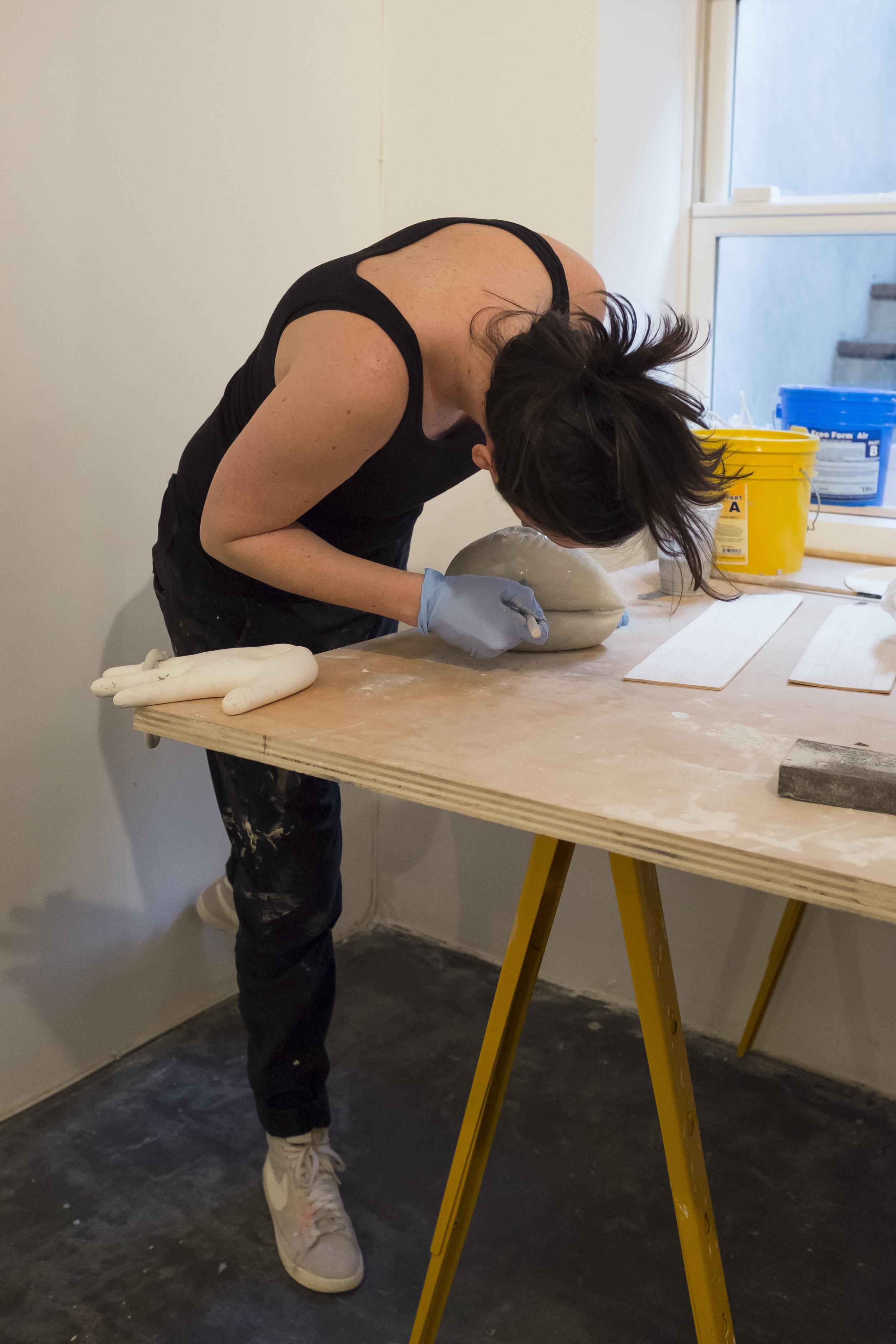
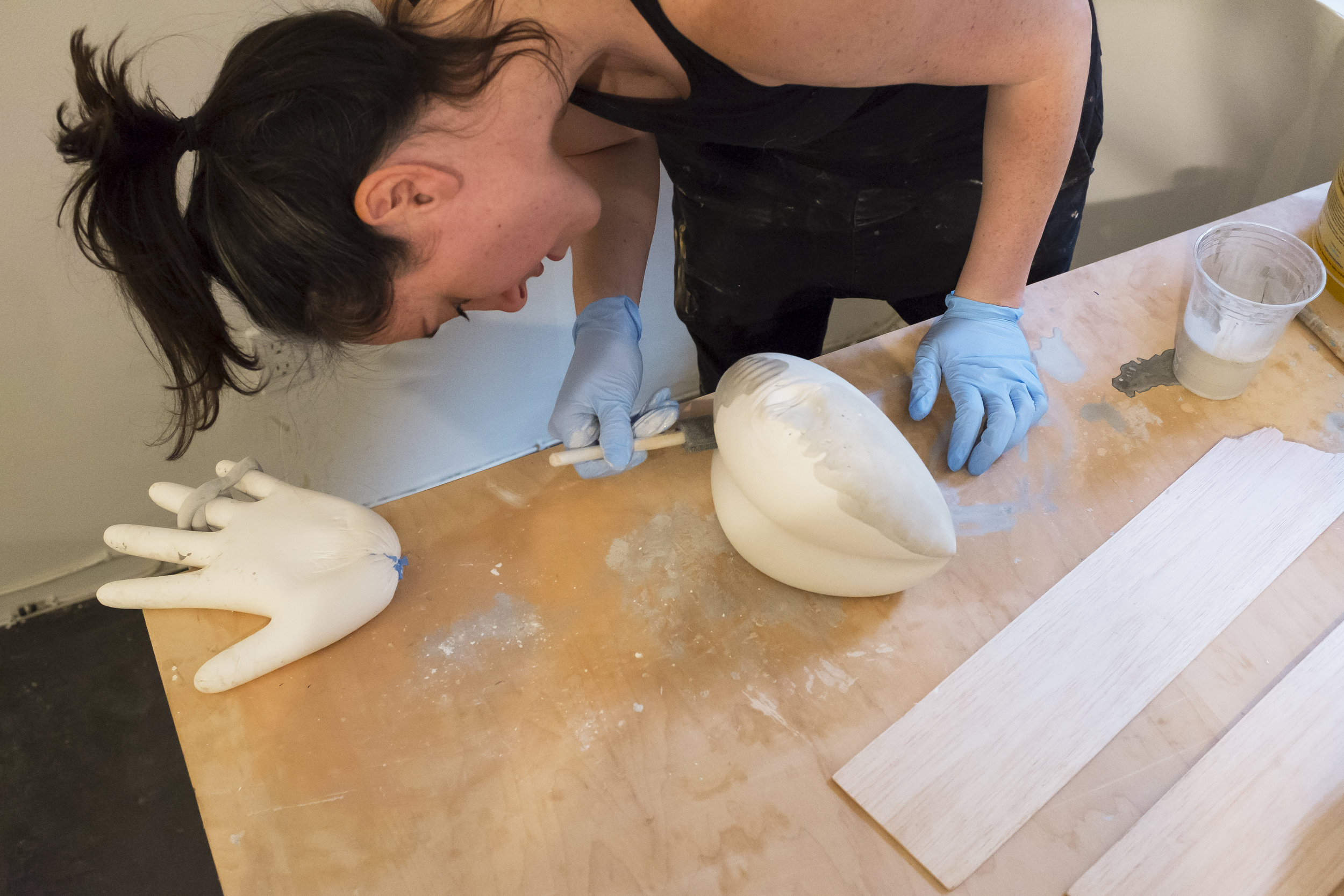
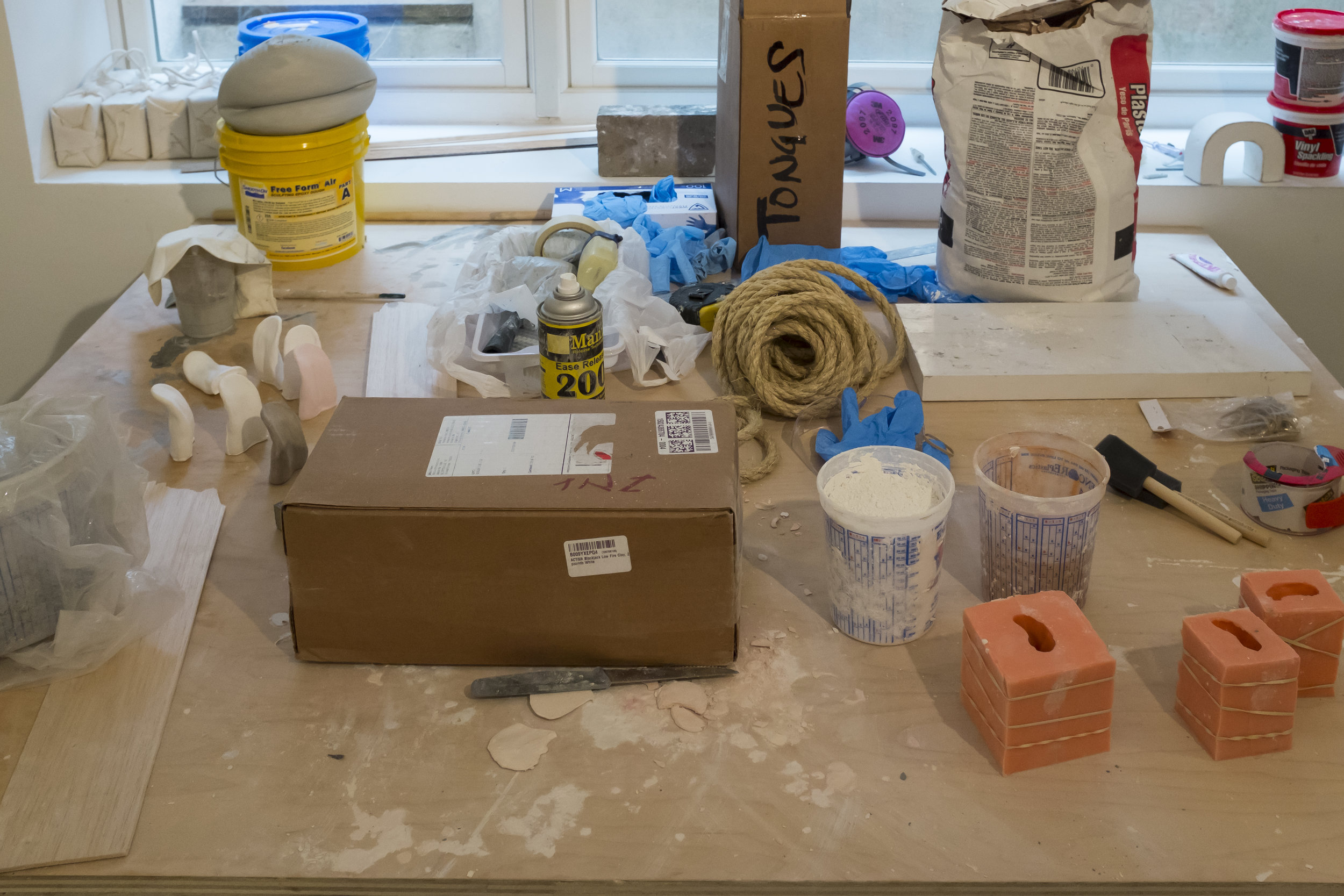
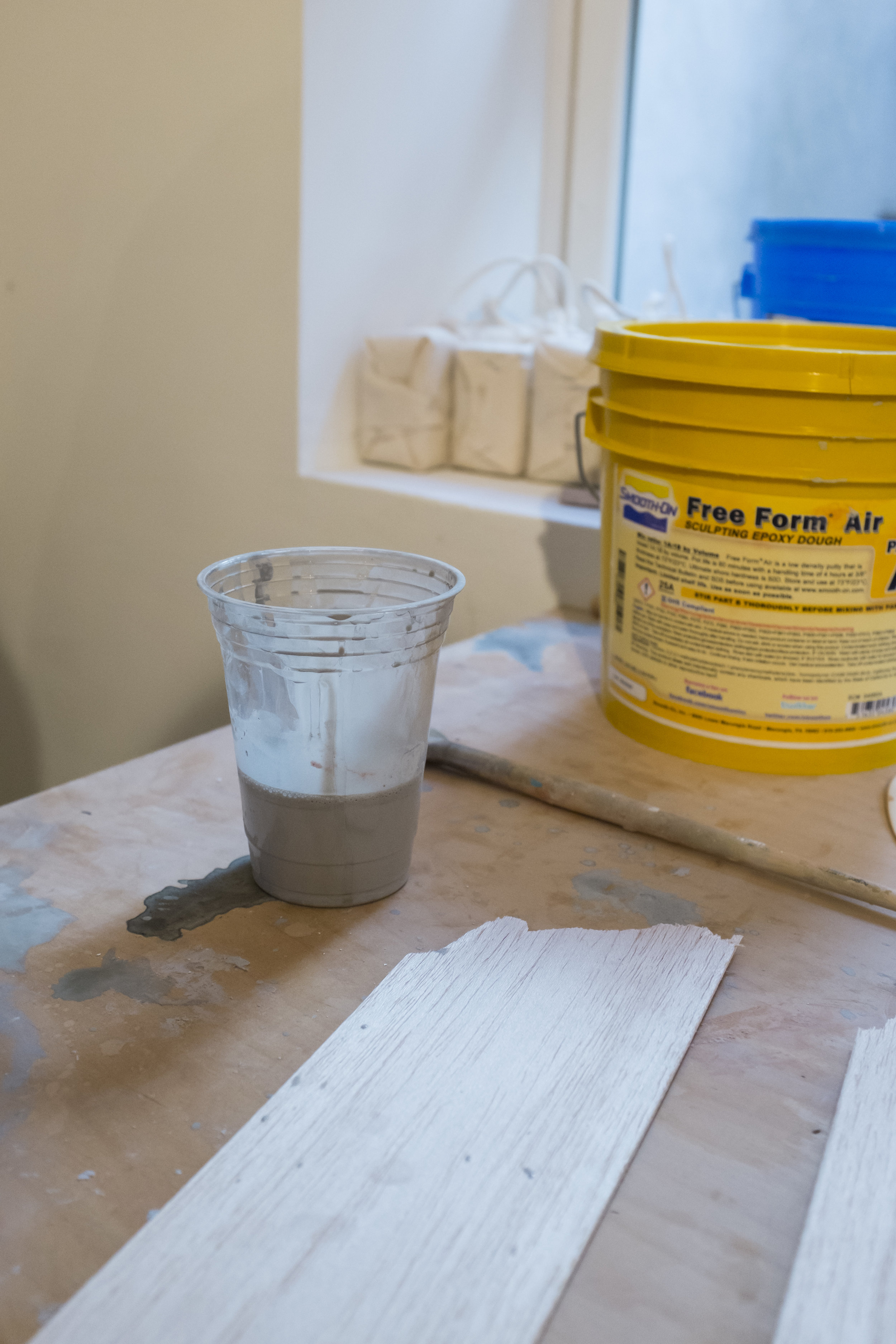
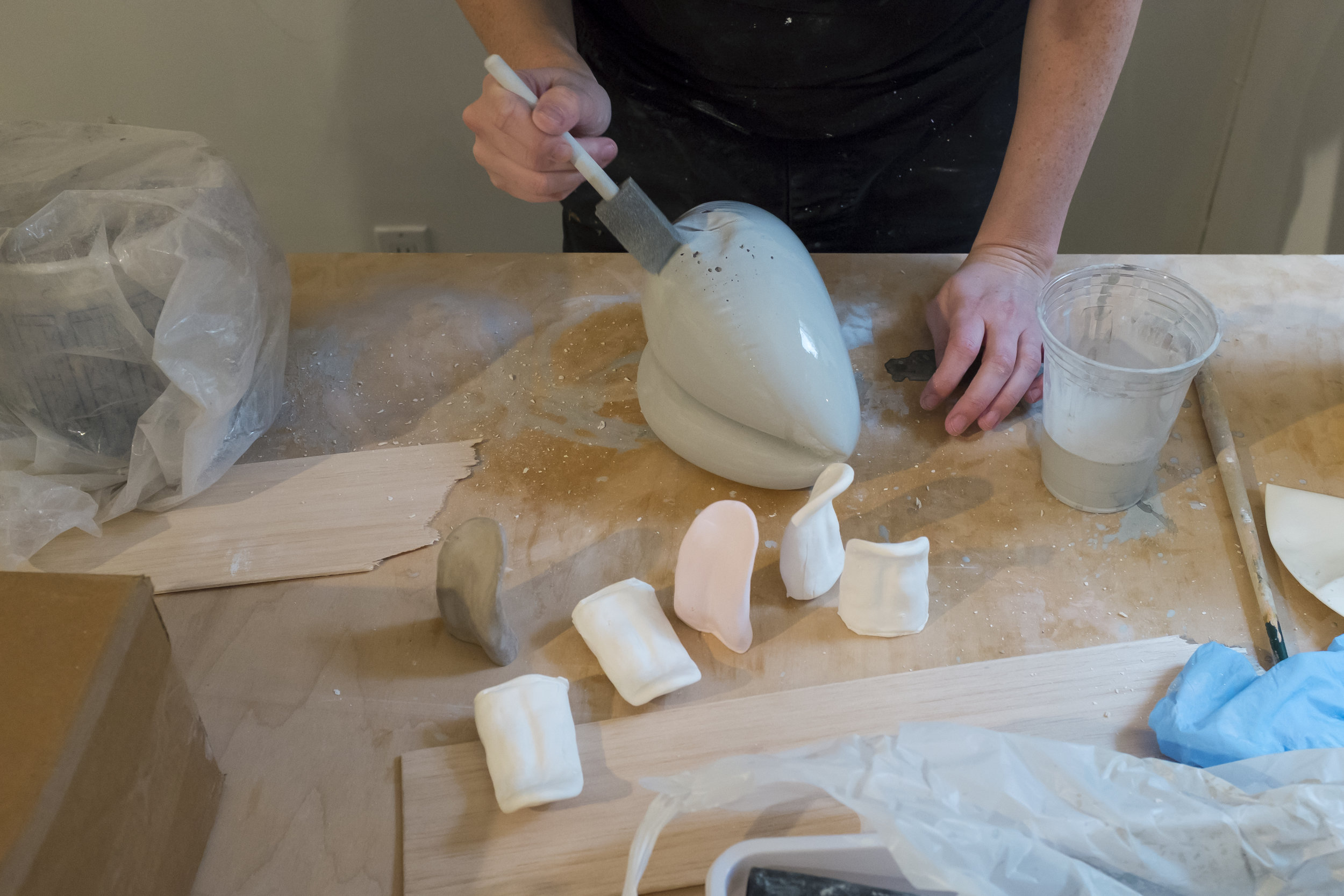
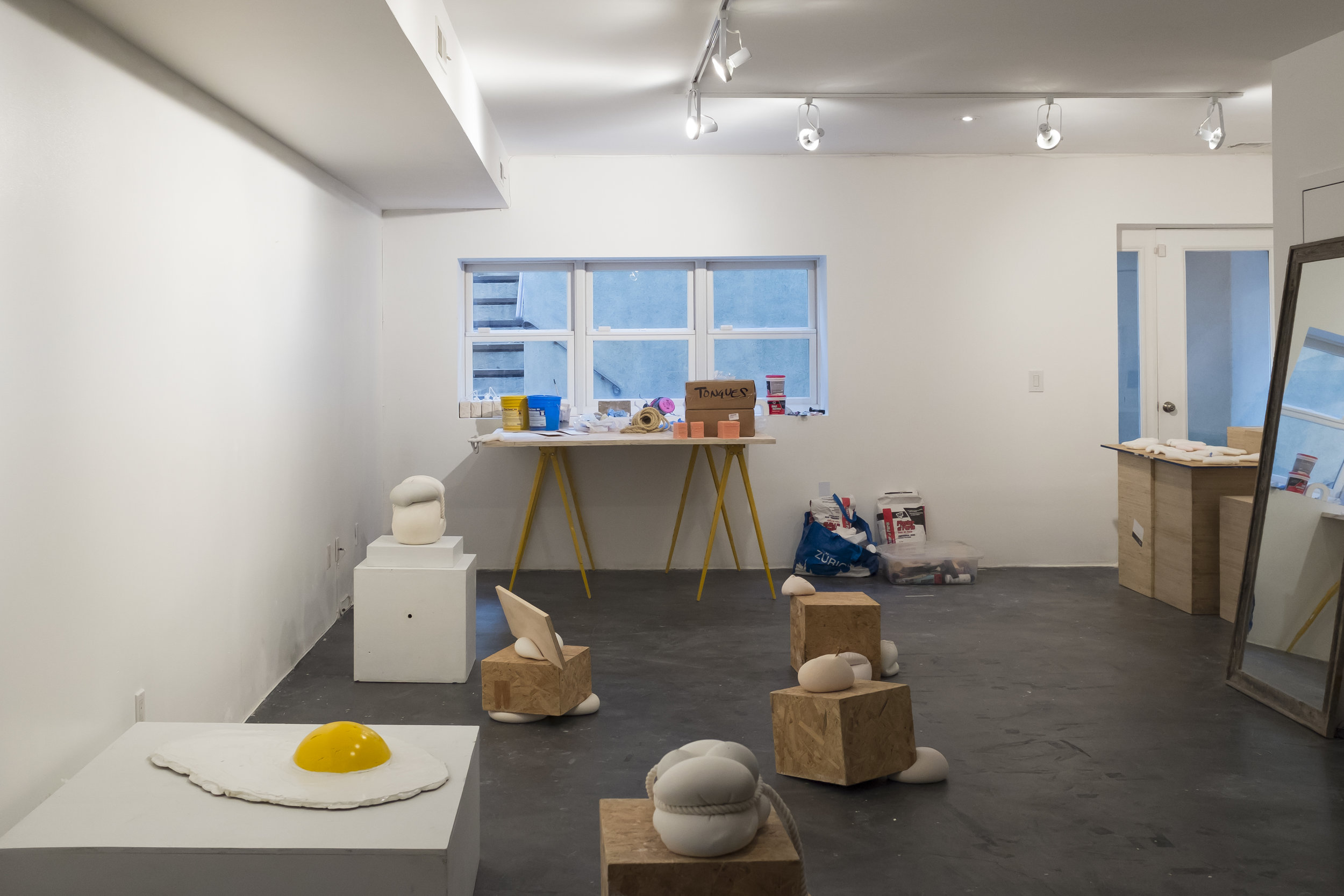
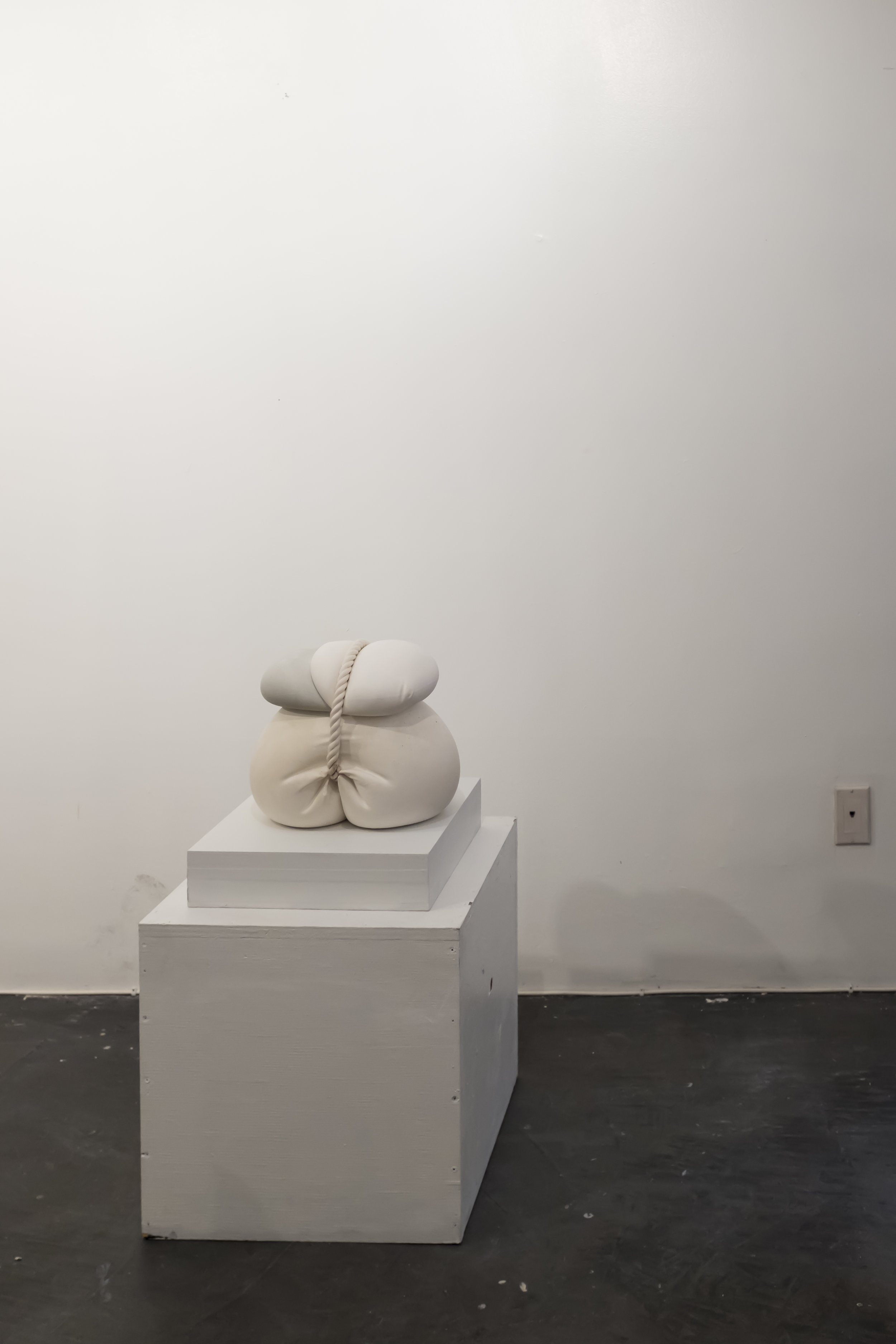
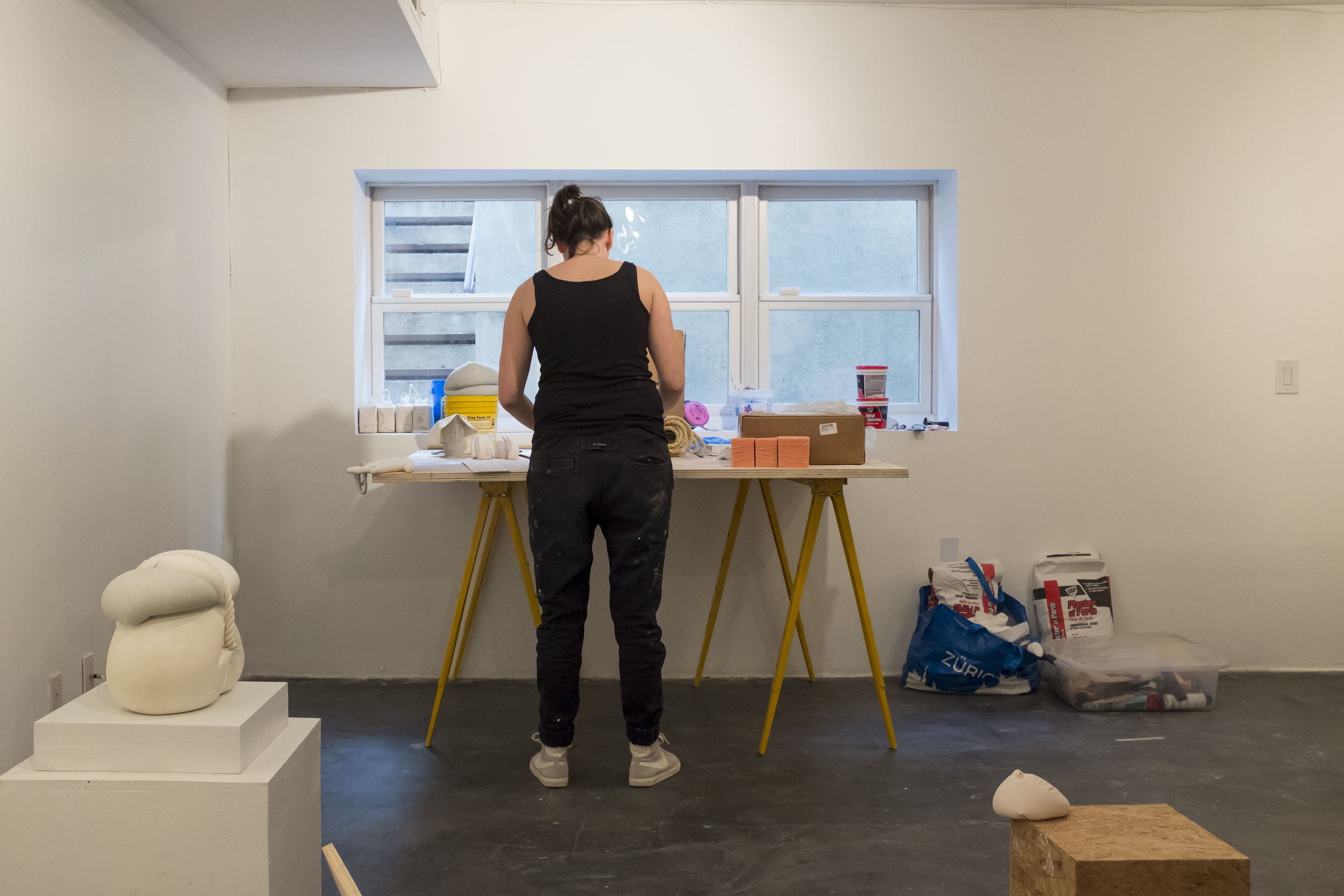
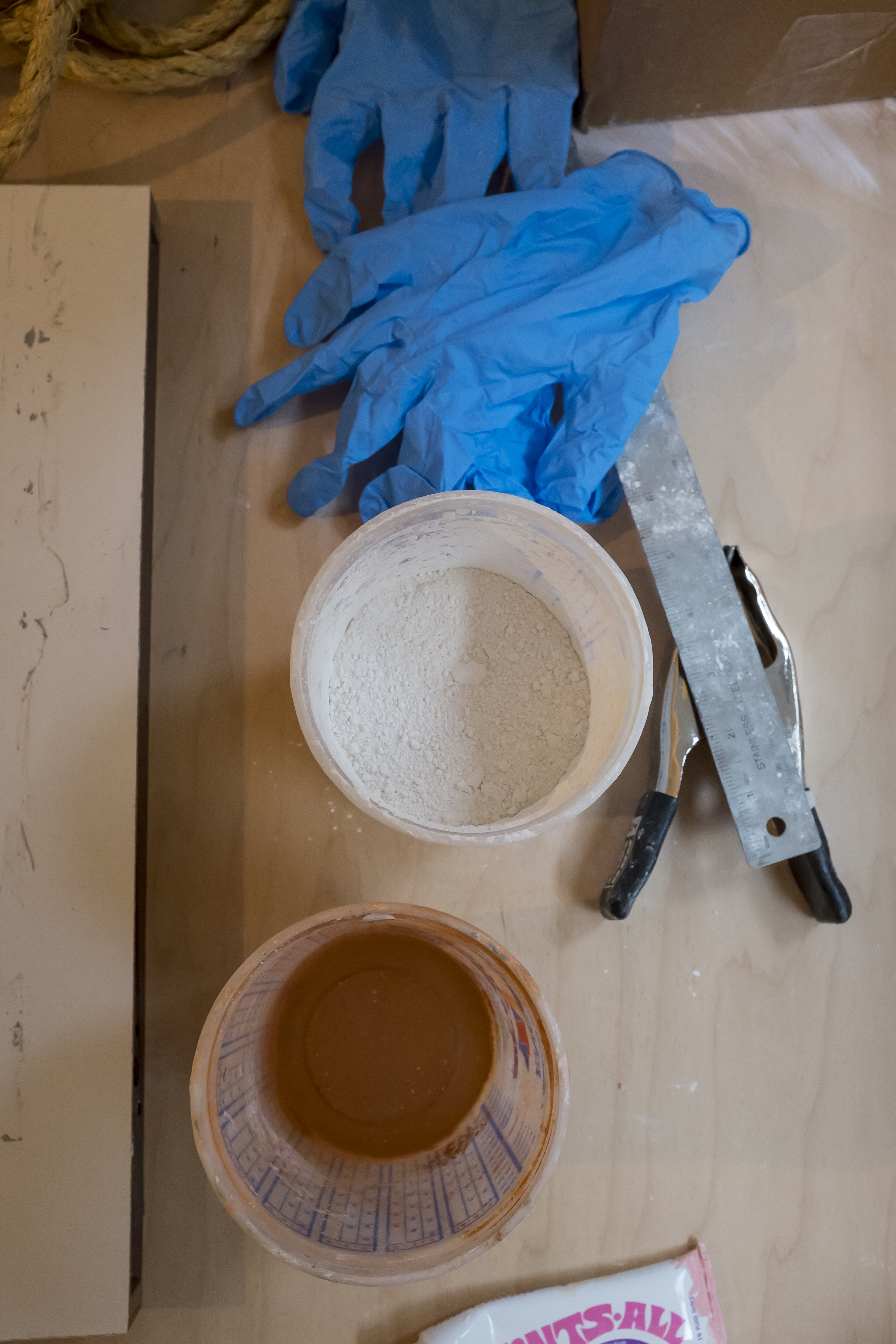
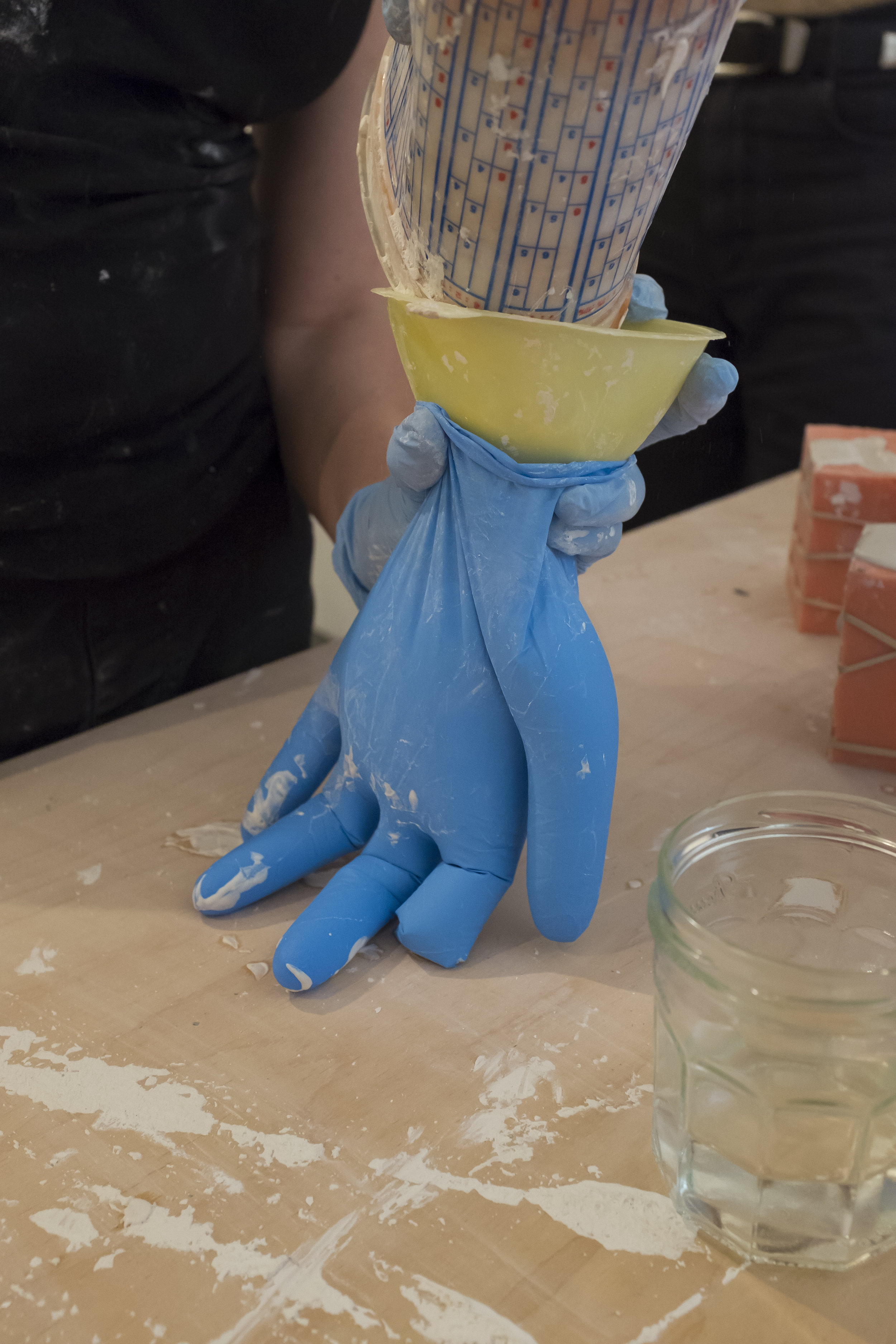
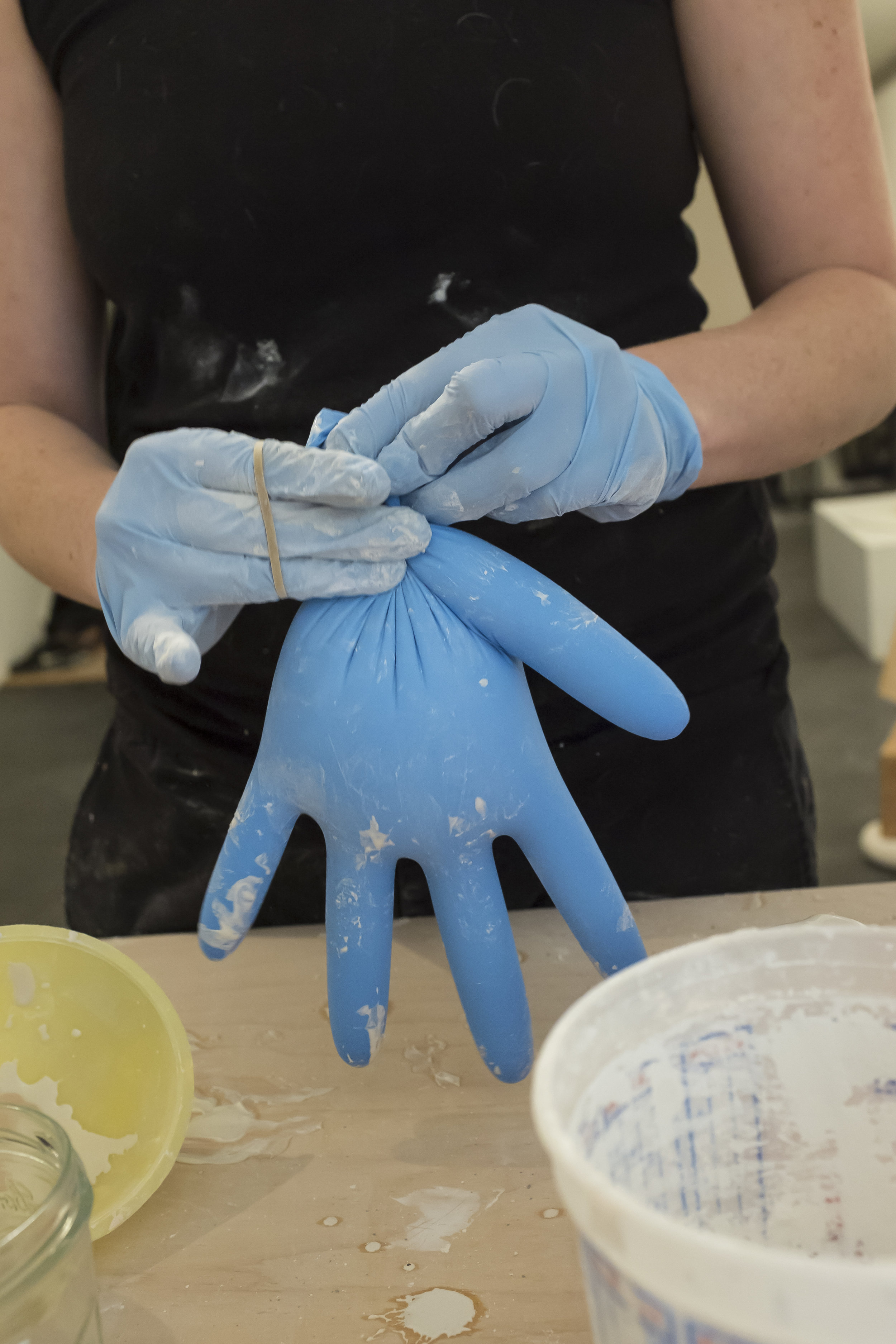
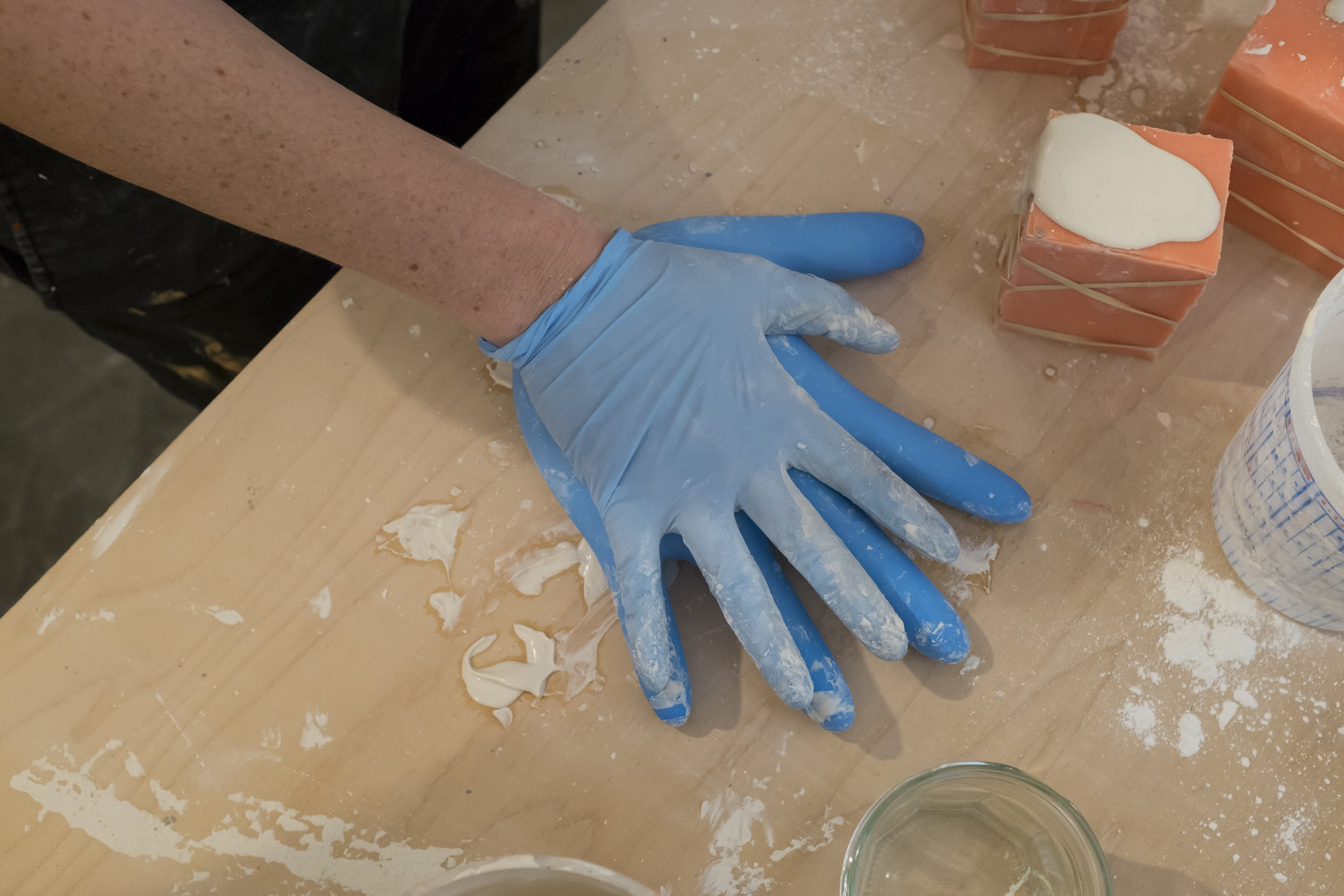
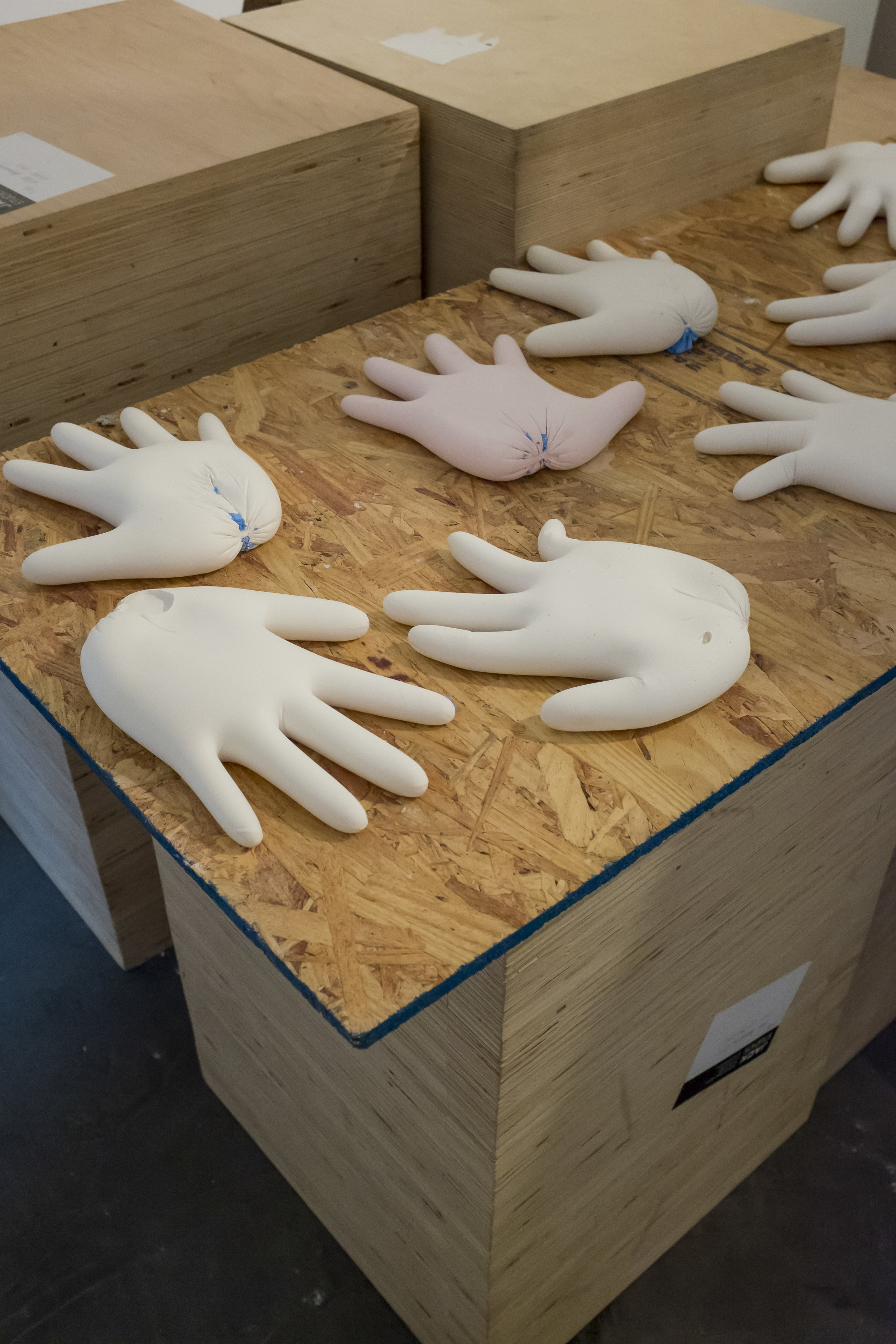
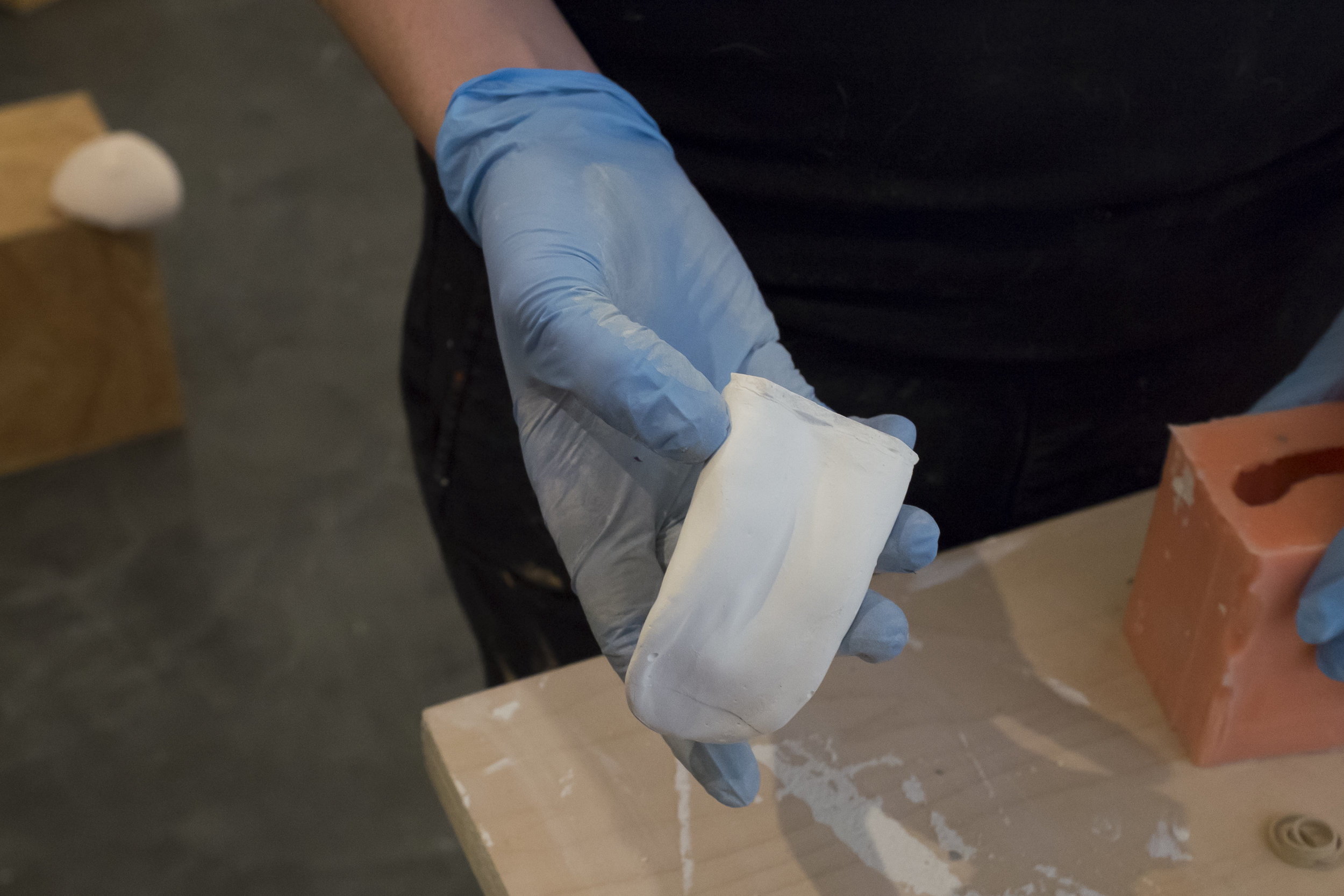
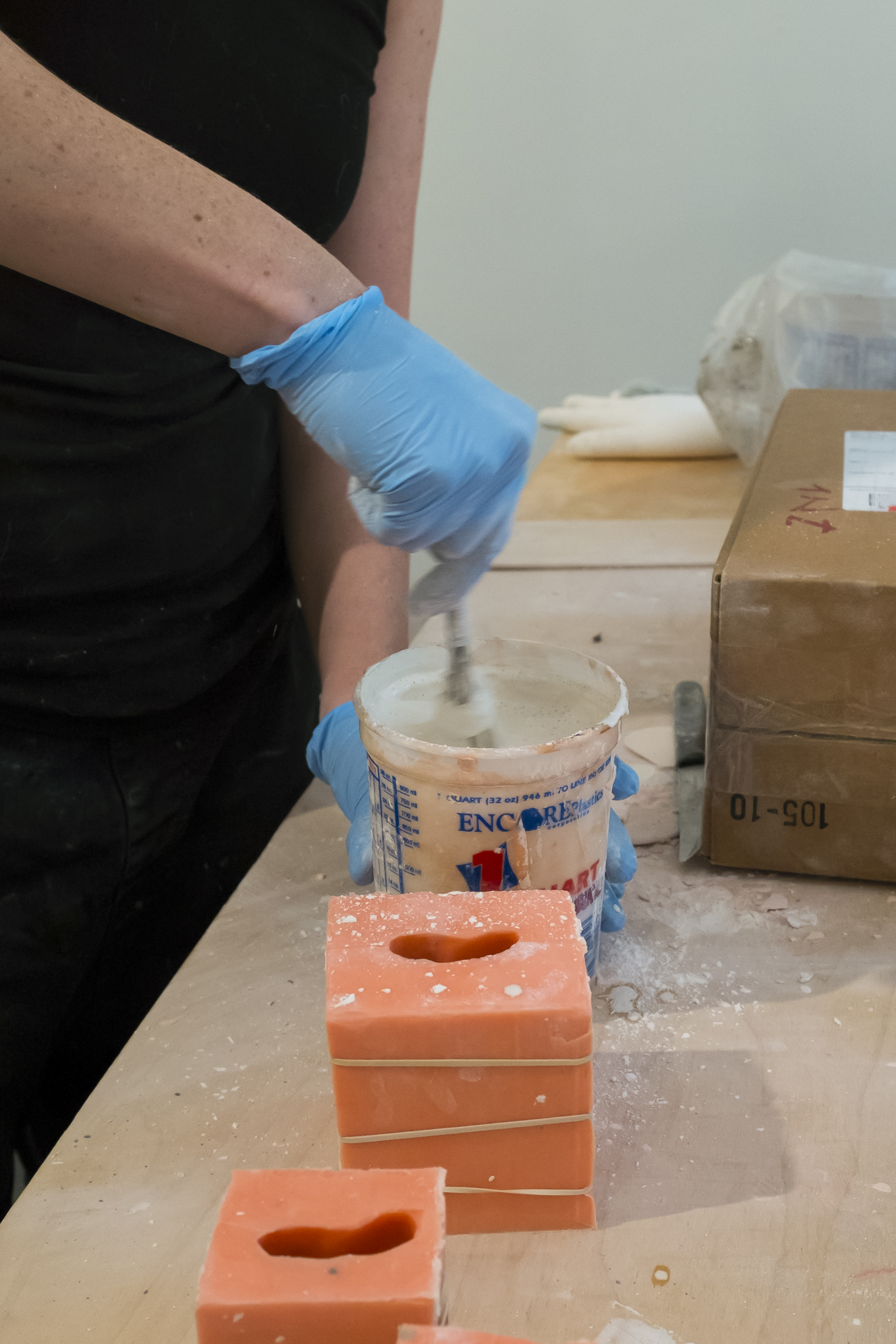
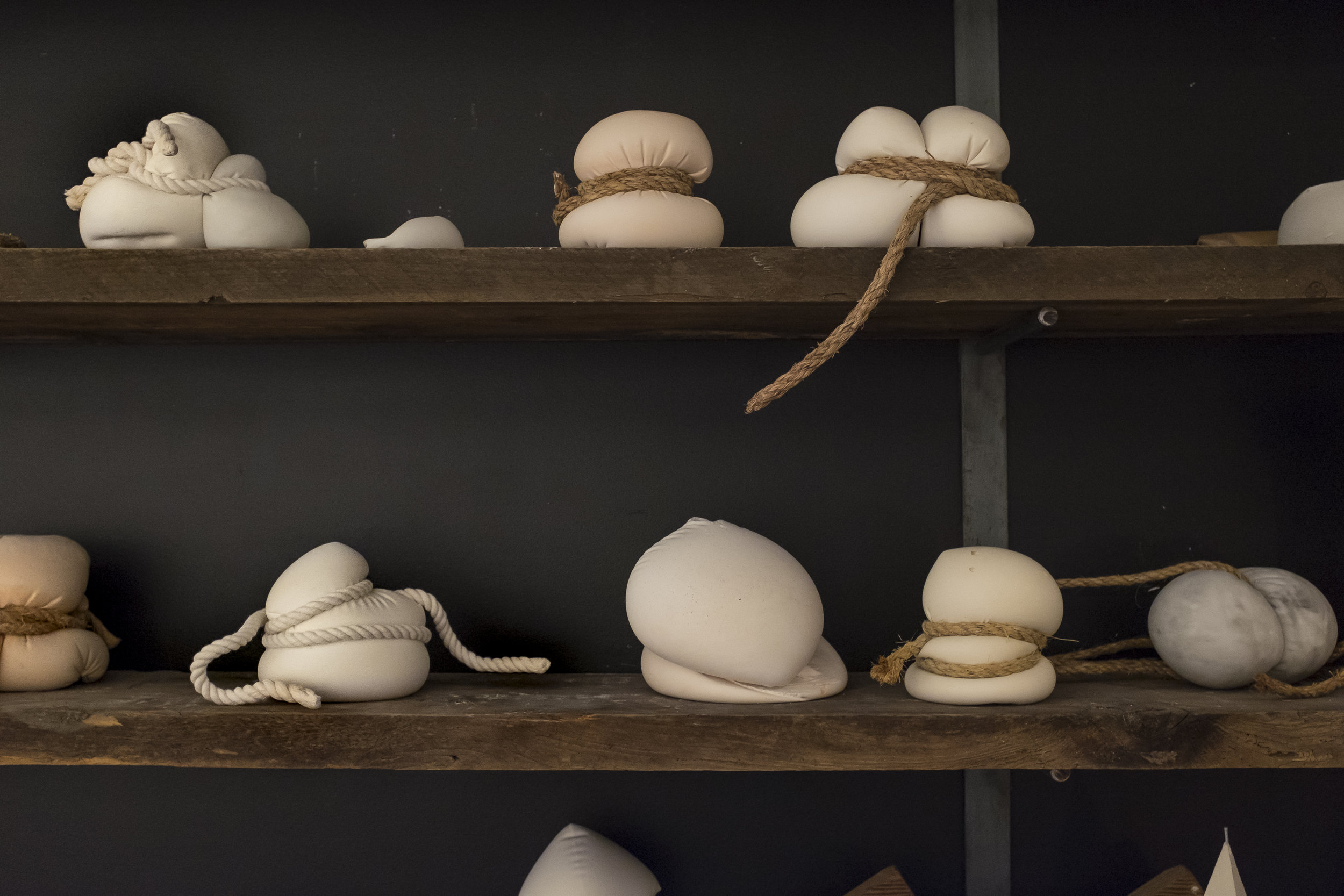

Stef Halmos
Who are you?
Oh, the existential question first. Who am I indeed? I think most people would probably start with this by saying their name and where they're from, but I'm not going to be that person. I’m an auntie to two small, beautiful little boys who I love. I’m a doting partner to my wife. I’m a feminist. I'm a sister. I'm a daughter. I'm an artist. And I’m dog owner to a small-headed, beautiful champion of a dog named Wolfie.
What do you make?
At the moment I make sculptures, although I've been letting myself off the hook a little bit and saying that I make objects because, for the most part, I don't know what is next. I feel okay about that. Five years ago I was making videos pretty much exclusively and now I'm making these hard, heavy, very difficult, not in any way precious objects. I've learned that I surprise myself pretty significantly in the studio.
Do you have a preferred medium?
I use a variety of materials in my work, and the less knowledge I have about a material the more obsessed I become with gaining that knowledge. So I make a lot of mistakes but I generally find that to be extraordinarily fulfilling. But because I am presented with such a variety of medium options in the world I actually prefer to work backwards and give myself constraints. One constraint that I have, for example, is that I don't use anything noxious. I don't want a little lump sticking out of my head in ten years, it's just not worth it.
I really like things that can be mixed and poured because mold-making is fun for me. So plaster and cement are materials that I tend to really love. They're cheap and they're quick to work with, which is important because, like I said, failure is an imminent part of what I do every single day. I also really like that they are typical construction materials. I buy them from a store that really only caters to contractors and then I make them into objects that I tend to believe are, in their own right, very feminine. Especially in the case of what I've been doing recently, taking plaster or cement and making it like fat flopping titties, I find it so fun to remove the material from its context.
Does your work make any critiques?
I believe so. I think that most artists would probably want to say yes to that, because there's not much of a point in doing something meaningless. I'm not saying that everything has to be critical, I think frivolity absolutely has its place. I'm certainly not making art that's necessarily referential to the academy or the market; it's not insider art. I like to believe that I'm an accessible artist, it's something I like about myself, it's something that I really try and stick to. So when I see myself getting extraordinarily academic or heady, or when I feel like my pedigree is creeping in a little bit, I try to use some inner-dodo to knock it out. But that said, I think a lot of what I do makes an argument for gut instinct as a significant working practice. If the end result of that process is a viewer looking at the work and feeling befuddled or amused or accessing their own imagination in a successful way, then to me that is meaningful. I will say that there are personal stories of living in the world as a queer female that I bring into the work, but I don't want to point at them because I just don't think it's fair to lead your audience directly down one narrow path, although that might be your narrow path. I would rather give them a big old field to walk through if they want to get to the work.
Under what conditions do you work best?
Happiness. I don’t make good things when I am sad. I’m not the poor starving artist or genius; maybe to someone else that is a reality, but that to me is such bullshit. I think that the myth of the free-spirited artist is a fallacy. Being an artist for me is so far from sexy. It is such a grind; it requires such commitment. I’ve been in the art world now for eleven years, and there have been multiple times where I’ve said, “I’m quitting, I’m not doing this anymore.” But I think that the more discipline that you have, the healthier and more stable relationship you have with it. Infrastructure is big for me. I do the best when I feel stable, when I feel happy, when I feel encouraged by myself, my partner and my colleagues. So I would say that the main working condition for me is joy. And a little cash flow doesn’t hurt. Both of those things I think are really key.
Do you have any rituals surrounding your process?
Here is what my days look like: I take Wolfie for a walk, I make coffee, I cook breakfast for Kenz, my wife, I bring my coffee downstairs, and I sit at my desk. I answer some emails, I sit in the bean bag chair - kick Wolfie out of the bean bag chair - and sketch for a while or read to clear some brain space. It doesn’t take long before I’m ready to work. If I have everything that I need in house, then I’ll get to it.
In my morning routine when I’m doing my emails with coffee and Wolfie, I listen to NBC News from the night before. Lester Holt is in my head from 9 AM to 9:30 AM - Lester Holt, Wolfie, Stef connected. Then typically when I work I listen to podcasts. Depending on my mood, it’s usually Teri Gross, Wolfie, Stef connected. Oh god, I love the sound of her voice. I’ve also been really into Anna Faris’s Unqualified, she’s fucking great. Sometimes they give such bad advice, but for the most part I love her, and her sincerity - sincerity is everything.
Also, when I get to work I always take my wedding ring off and set it next to my computer so that it doesn’t get all gross. That is another ritual.
Describe your process.
I always work on multiple things at once. Whenever something is broken or not working, I dump it right in the trash. I’m not precious; I don’t want to keep something forever and stare at it. Cement is a lot of fun for me. Spills are a lot of fun for me. Lately I have been rolling out long strips of clay and drooping them over things. That is so much fun, it is really a relief.
Usually when I work, if I am making something out of plaster that’s a sort of wet, heavy form, I use these long rubber sheets. When you put heat with rubber it will break at a certain point, but otherwise it gets kind of gummy. So I can heat it up - sometimes using iron, sometimes using a heated tip that you may use for wood burning - and then I sew the rubber into these little handmade balloons. I mix my plaster, pour it in, and let them set. That whole process takes a while. And usually those pieces are elements of a larger sculpture, which can take anywhere from three days to three weeks to complete.
I definitely am a nine-to-fiver in the studio. I hate working at night; I am such a morning person, it’s how I am. I usually work six days a week, but I want to do five. I’m not Jeff Koons in here, I can work five days a week and it’s fine; I’m not a hot shot. But I’m certainly a creature of habit. Richard Long did that piece where he walked back and forth on a field until the path was worn; it makes perfect sense to me. I want my whole life to be like that. It’s not to say that I’m not up to adventure and to go fuck off; that’s really cool and I do that at least once a year. But for the most part, I’m 9 AM in and 6 PM out. That is my world, that is the deal. I’m lucky enough to be able to do this full time now, which wasn’t the case for many many years. It feels really good.
What is the most challenging part of your process? Where do you find the most ease?
The number one challenge is quieting down my inner critic and amping up and celebrating my inner dodo. All the hurdles and all the walls I put up are totally self-inflicted, and a lot of that comes from the inner critic. The inner critic shouldn’t be totally eliminated because egos need checks, but they don’t need a bullhorn. That is the type of challenge that is very much ongoing. But there’s no reason why I can’t make whatever I want and there is no reason why I can’t have success from doing the thing I love. There is absolutely no reason.
Fun is easy; I like to have a really good time by myself. With dope tunes, a good attitude, and snacks down here I’ll just have a really good time. I make cool shit when I am having a good time. That is not very articulate but it is a fact. Let’s put the artsy terms away for a sec… Having a good time makes for good work.
Does your work interact with the space in which it's displayed?
Yes, it's very important to me. I usually like to see the space ahead of time. I like architecture. I like a room with endless possibilities. So definitely responding to space is something that happens in my practice. I think with this work, these blobby tits and guts as I call them, I do tend to like the idea of them completely taking over, drooping off the wall and through the window. When I make these singular unique pieces I like to put them in a room one by one and start to overwhelm the space. But I also have no problem with putting one object into a space and letting it have some power. I guess it really just depends on what I'm making, but the space certainly plays a significant role in my way of thinking.
Does feminism play a role in your work?
When I was a student and in my early twenties, feminism became something that I was organizing around and participating in, both academically and socially. I became convinced that I needed a specific access point and I needed to be able to say that my art was feminist for a specific reason. That isn’t real to me at all anymore; I don’t think it is very useful. I was trying to pigeonhole myself so that I could defend the work that I make, but now I just don’t need to defend it. So, for me now, I know that I am a feminist, I know that a lot of the work that I make has to do with my guts. The idea of the wild womanly nature in chaos in her studio is really fun for me. Let me live there, let me live as a wild woman forever. That’s great and that’s enough.
The objects that I make are not feminist because I make feminist art by any stretch of the imagination. They are feminist because they’re made by someone who is engaged in a feminist dialogue in all aspects of her life. That’s about as much as I would give; the viewers can take away anything that they want from the objects. In fact if someone wants to be like, “these are chauvinist,” then fine, yeah, cool. If you can make an argument for that, I’ll listen.
What are your views on interactivity in art?
One of the things that I find really sad and troubling is going to an institution or a gallery with someone who, when asked what they think of the work, somehow doesn’t feel adequately qualified to have an opinion or any sort of response. That to me is absolutely something that I hope to avoid. I'm not saying that it's completely possible to avoid, because what I am doing as an artist is synthesizing social, political, and personal experience, chewing it up and spitting it out in the form of an object, so of course it's not going to be accessible to everyone because art is just not accessible to everyone. But that said, you don't need to know the history of all the women that Picasso fucked in order to go look at a Picasso painting. So when I talk about interaction in the context of my work, I don't mean that I intend to make art that blinks at you and that you stick your hand inside. I just want to believe that even at the most basic level, even if someone looks at a piece and wonders how it's made, there is, at least, always a point of entry. Ultimately, if someone can stand in front of my work and say, "I like it" and then stand there for a little longer and think about why they like it, that's great. And the same thing goes for not liking it. Of course I hope that it pushes further. I hope that some of these things that I make really piss someone off. And I hope with equal measure that someone looks at the work that I do, not necessarily right now but in the long run, and maybe it really touches them or maybe it makes them laugh hysterically. That is the type of access that I'm interested in. I don't want anyone to have to wonder if they need a certain credential in order to be looking at this work and commenting on it. So interactivity in terms of accessibility is where I want to start. I’d like to think that overall I can be the type of artist that can talk to anybody about what I'm doing and figure out a way to have some common ground.
What role does social media play in your practice?
I spend such an embarrassing amount of energy on Instagram. I'm not proud of that. But it's such a necessary evil. It's important that I have it and use it. Really it is something like a little gallery. Social media also adds this element of celebrity and charm and behind-the-scenedness that has become important. You have to be the whole package now. I certainly expect that from other artists.
Do you think that commissions tie into making your work accessible?
Commissions do have that dual benefit. I get a lot of emails from people, often through Instagram, who really like the work but who think that they can’t afford it. But if someone really wants something, if someone is really compelled by the work that I make, I don't ever want to put up a barrier between them and that thing. So I would much, much rather make something specific for someone, even if that means scaling it down or making something a little less labor intensive so that we can work out a price that is reasonable for them and that doesn’t devalue the work. I want to enable people to start collecting art. Everyone deserves a shot at building an art collection.
How have you learned what you know? Did you have any teachers or mentors who helped shape you as an artist?
So many people have helped me in so many different ways, it’s unbelievable. I have a good friend, Chris, who I met while working in a studio of a famous sculptor. I call him my technical consigliere because he’s just a material genius. This man works so hard but he always makes time for me and he’s a good friend. I’ll just text him and be like, “Hey! Do you think that this wood saw is a nice little handsaw and won’t chop my finger off?” And he’ll say, “Yeah, but you should look into a compact saw instead, here’s a link on Amazon…” It’s people like him, colleagues, that end up helping me the most. I also have a friend Maysha Mohamedi who’s an incredible painter, and we check in with each other a lot and talk. So on one hand there are people who really help me material-wise and technically, and then on the other hand there are people who are a great sounding board to realize that you’re not alone in the studio during the day.
I would also say that my wife helps me in a lot of ways. She can come down to the studio and give feedback in a very immediate way. My wife is so intelligent and so in tune to what I do down here that she can look at something and see it in a way that I haven’t yet. I can respond to that immediately and that is really important.
Lastly I’d say that my parents have helped me a lot with so much encouragement all through the years. My dad is an entrepreneur and has taught me to embrace my inner entrepreneur, which has really helped my art practice. A lot of that has to do with empowerment and with asking for the things you want, and not fucking apologizing. I trained myself against the apology by watching him manage his life with such intelligence and grace in business.
Is there anyone or anything that inspires you?
Right now something that I am fixated on - this is so weird but I am obsessed with it - you know how your gut, your colon and your intestines make a pattern? When you get surgery that involves removing a part of the intestines, the surgeon takes them out, and shlops them onto a table like spaghetti. And then - this is the amazing part - when they put them back the surgeon lifts them up, shlops them into your body cavity like a bowl of spaghetti and stitches you back up. Then as you live your life, they reset into their pattern. That is what I am obsessed with right now. I am just amazed that the body is smart enough to know where that goes. There’s something so funny about that, and so beautiful and so disgusting.
But there are a lot of people who inspire me too. I’m really into Amy Schumer, she’s a big inspiration for me in general- I love her. I like a lot of comedians. I would say that stand-up comedy is like postmodern theory. It functions very similarly in that people observe things and experience things - they might be very troubling and really difficult - and then they chew it all up, spit it out and make you laugh. You’re laughing but you’re learning. Comedians inspire me to think politically and to be brave, so I look to comedians a lot right now. And spaghetti guts.
What’s the best piece of advice you’ve ever received?
I have two really good pieces of advice. The first one is to ask for the things that you want. A lot of people just don’t ask. If you want something, go get it. The second thing I’ve learned, which is on a more personal level, is that the story doesn’t change until you start telling it differently. I got that advice in grad school from a faculty member, Tammy Rae Carland, who’s this really great artist and cool lady. I use it in my life a lot. But I always try to remind myself that it’s not about acting. Vulnerability is great, I’m all for it. What is important is to remember that I can author my own story. No one else has control over that. I can handle my my career, my work, my influences, what I read - I can see them in my own way and process and respond to them in my own way. This connects to authenticity as well; it’s about the way we carry ourselves and communicate. If something is authentic to me it will be received as authentic. I think that art goes through so many cycles and trends, and the more that you stick to your guns and make the things that you really want to make, the more honest you are with people. It is your story and you get to say it the way you want. It’s as simple as that.
I think that when you’re younger it can be really difficult to remember that. If there is any advice that I would give to young artists it would be to spend your entire twenties not worrying about the art world - just don’t fucking do it. Work your day job, make art at night, and take any extra change you have and use it to travel. I spent a lot of time working for artists and working in the art world, and in the end it was like eh, actually I can do this. Just stick to your guns. Own it. The gut is good stuff. Spaghetti.
What has your practice taught you?
So much, oh my god. It has taught me so much because it takes so much patience to be an artist. It took ten years before I was able to not have a real day job and could do this full time. It has taught me to be nice to myself because a lot of the time I make mistakes and for years I was having a hard time making ends meet. So it has taught me to do the work and see the results. That’s one cool thing about being an artist - if you do the work, you have a thing you are looking at that shows the work that you did. It doesn’t stop; the learning doesn’t stop. I really don’t know that much and I’m trying to know a little more all the time, whether it’s something as obvious as material or as complicated as needing to undo the art history that I have learned in order to make good art.
How has your practice shaped your hands?
I have such horrible hands. My hands are just always gnarly. It has shaped them in that I always have stuff under my nails. I’m very envious of women that have very sexy, pretty hands, like the type of hands - this is gross - that you could see them putting in someone’s mouth. Like I never want to dip my hands in my wife’s mouth because I’m like, “No, you deserve better.” So it has shaped my hands in that it has made them not that cool or pretty looking.
But anyways, hands. They are the key, they are important. My hands are good, they are strong and they do what they need to do.
Stef Halmos in Brooklyn, New York on February 10, 2017. Photographs by Julia Girardoni.
